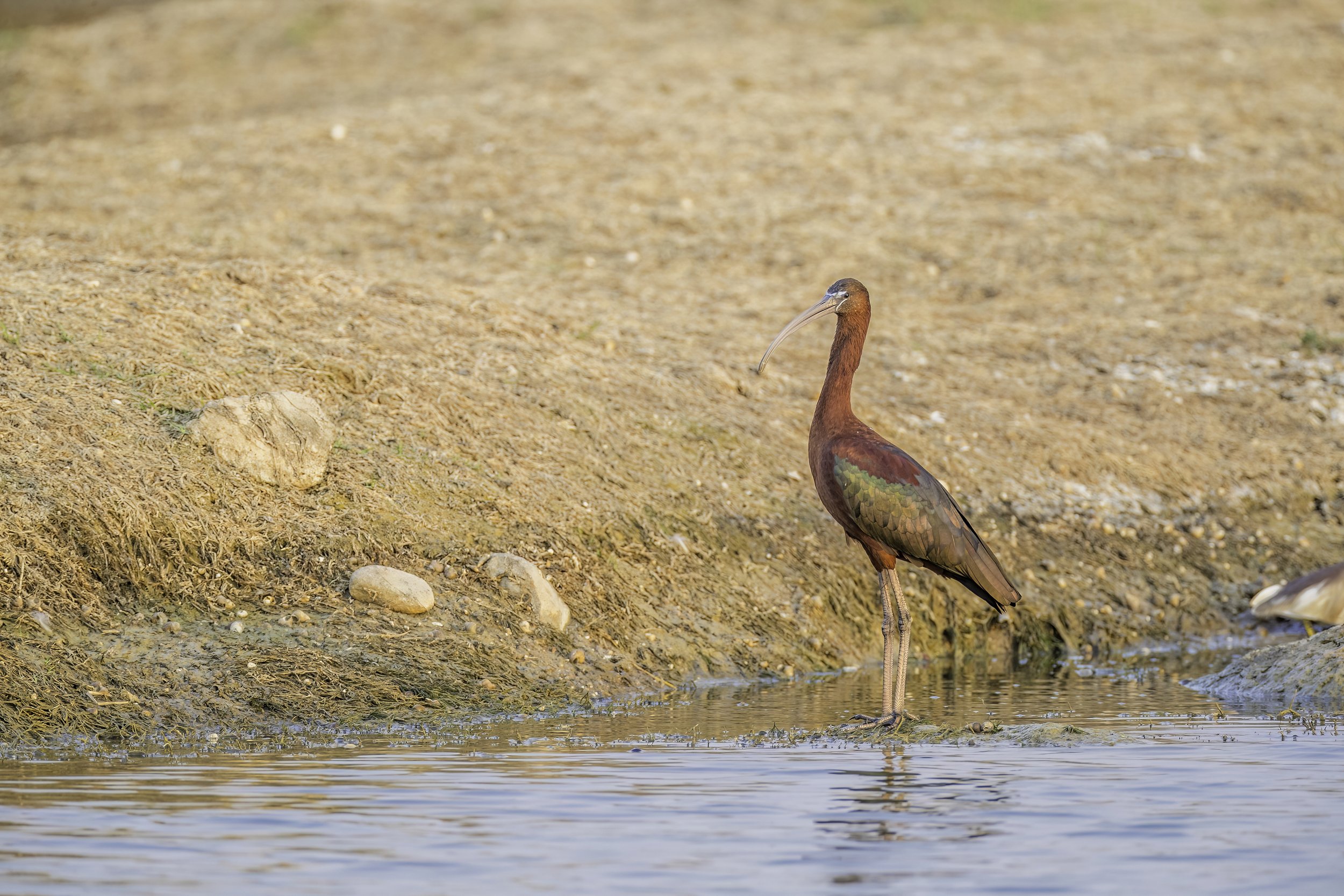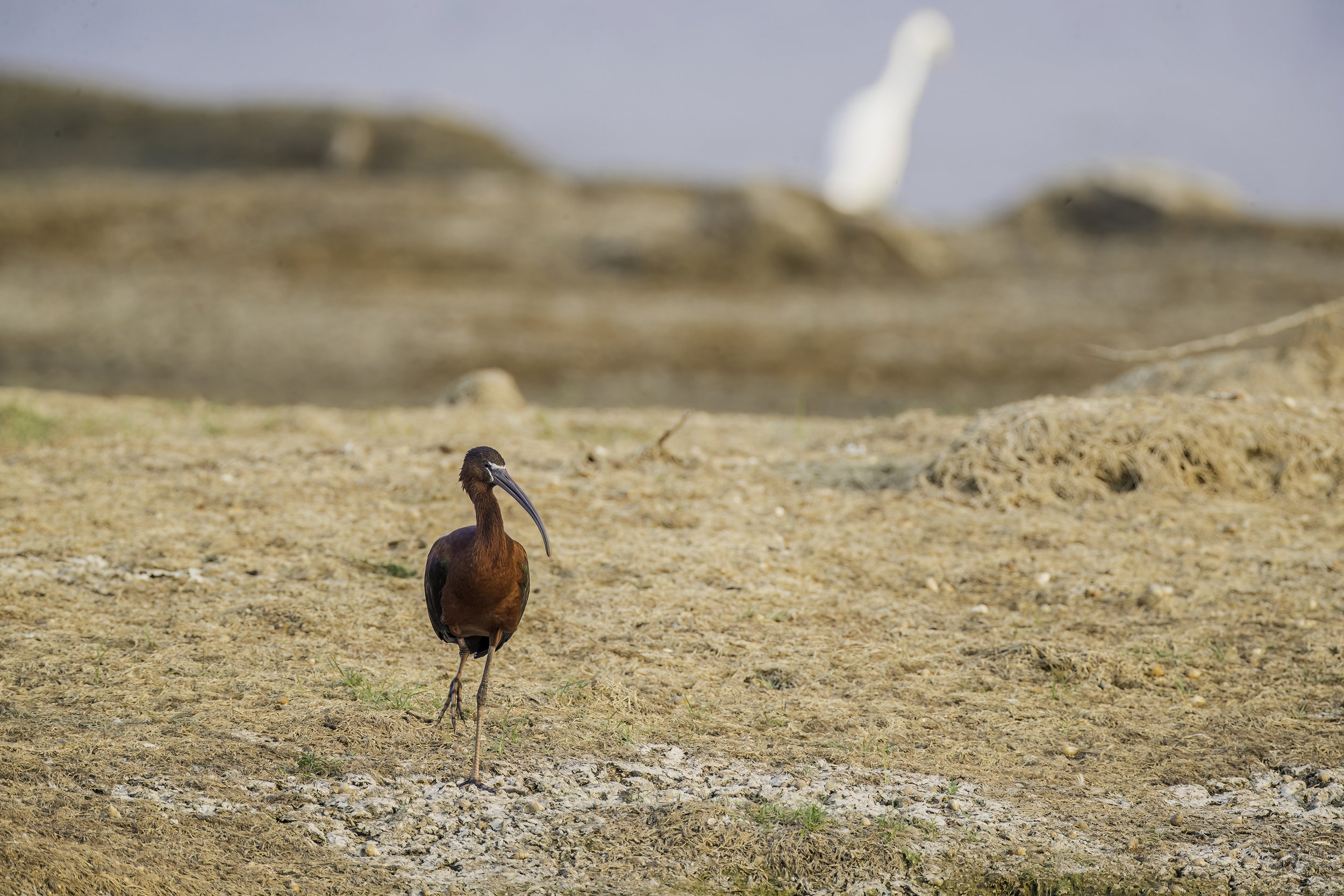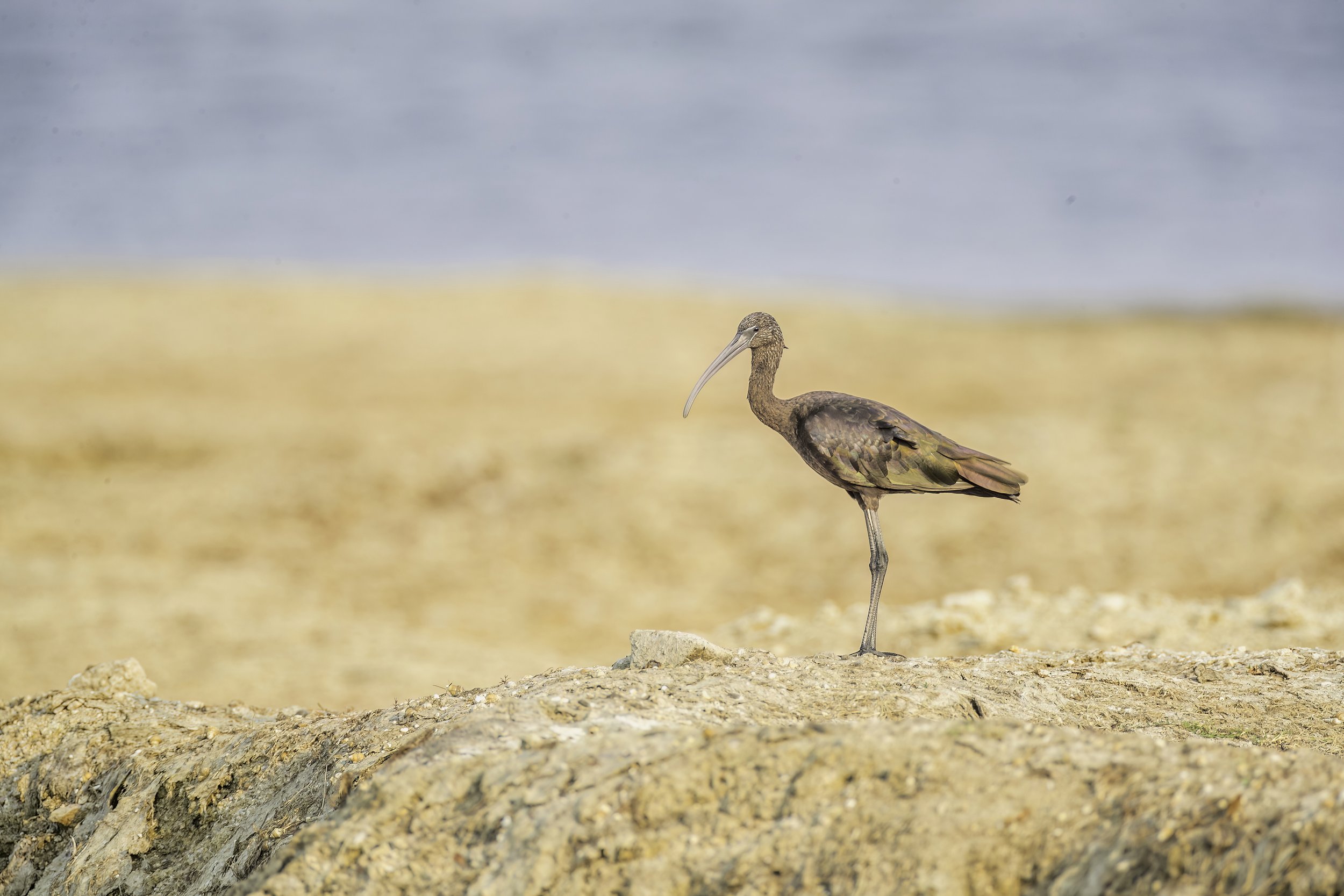Glossy Ibis
Plegadis falcinellus
Ammavaripeta Cheruvu, Warangal & Bhigwan Bird Sanctuary
Renowned for its extensive natural resources, breathtaking scenery, and rich cultural legacy Telangana is the eleventh largest state in India situated on the south-central stretch of the Indian peninsula on the high Deccan Plateau. It is the twelfth-most populated state in India with a geographical area of 112,077 km² of which 21,214 km² is forest cover. The dry deciduous forests ecoregion of the central Deccan Plateau covers much of the state, including Hyderabad. The characteristic vegetation is woodlands of Hardwickia binata and Albizia amara. Over 80% of the original forest cover has been cleared for agriculture, timber harvesting, or cattle grazing, but large blocks of forest can be found in the Nagarjuna Sagar - Srisailam Tiger Reserve and elsewhere. The more humid Eastern Highlands moist deciduous forests cover the Eastern Ghats in the eastern part of the state. The Central Deccan forests have an upper canopy at 15–25 meters, and an understory at 10–15 meters, with little undergrowth.
The dry sub-humid zone or Dichanthium-cenchrus-lasitrrus type of grasslands are prevalent here and cover almost the entirety of peninsular India except the Nilgiris. One sees thorny bushes like the Acacia catechu or Khair as it is known in Hindi, Mimosa, Zizyphus (Ber) and sometimes the fleshy Euphorbia, along with low trees of Anogeissus letifolia or Axle Wood, Soymida febrifuga - the Indian Redwood - and other deciduous species. Sehima (grass) which is more prevalent on gravel is about 27% of the cover and Dichanthium(grass) which flourishes on level soil is almost 80% of the coverage.
Telangana's extensive network of lakes, which enhance the state's scenic appeal and serve a vital role in delivering water for irrigation, home usage, and industrial reasons, is one of the state's most notable natural characteristics. Telangana has lakes due to its geography and the copious amounts of rain that fall there during the monsoons. Telangana is home to some of India's most stunning and ecologically significant water features, with over 6,000 natural and man-made lakes. Endowed with a rich natural resource base and a diverse environment, there are many lakes in the area, both natural and man-made, which are significant water supplies for industry, domestic use, and irrigation. The lakes of Telangana are a crucial component of the area's ecosystem and provide a habitat for many different plant and animal species. Many of the state's numerous lakes, which range in size and depth and provide visitors with breathtaking views and leisure activities like boating, fishing, and bird watching, are well-liked tourist destinations. Telangana's lakes visually represent the state's natural beauty and ecological diversity, from the picturesque Hussain Sagar Lake in Hyderabad to the tranquil Pakhal Lake in the Warangal district.
Today I am at the Ammavaripeta Cheruvu, a small lake some kilometers away from the ancient city of Warangal. Over the last few months this small lake has garnered attention for having an unusual visitor - the Spur-winged Lapwing. There are many such locations across Telangana which are home to migrants and seasonal visitors and every experience of seeing a new bird provides a rush that one can only feel by doing something they love. As I mentioned in an earlier blog, bird and wildlife watching is a great form of recreation for people of all ages and always provides an opportunity to learn something new.
But today is about another inhabitant of this beautiful lake - the Glossy Ibis.
Ammavaripeta Cheruvu
Ammavaripeta Cheruvu is a small lake some kilometers away from the ancient city of Warangal, the erstwhile capital of the Kakatiyas. It is one of the few unpolluted lakes in the area. Located about 1.5 km from the ancient Kakatiya capital of Warangal and 3 km from the town of Kazipet, surrounded by lush green fields, the lake was constructed in AD 1213 by the Kakatiya king Ganapati Deva. The lake lies in the precincts of the village of the same name falling in the Hanamkonda Mandal in the Warangal district. A peaceful village, its claim to fame is the Sammakka Saralamma Jatara, a tribal Hindu festival to honour the tribal goddesses. Held every two years to honour the goddesses Sammakka and her daughter Sarakka (also called Saralamma), it is the time for the largest tribal congregation in the world with approximately 10 million people converging on the site over a period of 4 days. The devout offer Bellam (jaggery), locally called Bangaram (gold), to the deities. The jatra begins at the remote village of Medaram in Tadvai Mandala in the Mulugu district, deep in the Etunagaram Wildlife Sanctuary, one of the oldest sanctuaries of Telangana, and a part of Daṇḍakāraṇya - the largest surviving forest belt in the Deccan and mentioned in the epic Rāmāyaṇa. All rituals to the goddesses are performed by the priests of the forest dwelling Koya Tribe (Koitur in Koya Bhasha) in accordance with their customs and traditions. This intangible cultural heritage of Telangana is believed to attract the largest number of devotees in the country after the Kumbha Mela.
There are many legends about the miraculous powers of Sammakka. According to a 13th-century tribal legend, some tribal leaders on a hunt found a newborn girl (Sammakka) enveloped in light playing amidst tigers. They took her to the tribal chief, who adopted and raised her as a leader. She later became the saviour of the tribals in the region. She was married to Pagididda Raju, the tribal chief of the Koyas. Medaram was ruled by the Kakatiyas from their capital in Warangal between 1000-1323 AD. Sammakka had two daughters and one son, Sarakka alias Saralamma, Nagulamma, and Jampanna. King Prataprudra of the Kakatiyas imposed taxes on the Koya Tribe, which they could not pay. As a result, King Prataprudra declared war on the Koya Tribe. Pagididda Raju was killed in the ensuing battle forcing the grief-stricken Sammakka to pick up the fight with her daughter Saralamma, her son Jampanna, and her son-in-law Govinda Raju. Sammakka had almost won when Saralamma died in the battle. Jampanna was mortally wounded and fell bleeding into Sampangi vaagu (stream). Legend has it that the stream, a tributary of the mighty Godavari, turned red from the blood, and the stream was renamed "Jampanna Vaagu" in honour of Jampanna's sacrifice. Distraught, Sammakka retired to a hill called Chilakala Gutta and turned into a turmeric jar (kumkuma bharani) filled with kumkuma powder. After the battle, Sammakka and Saralamma were deified and a festival or jatra was organised in their honour once every 2 years. To this day, the Koya tribe and devotees believe that Sammakka and Saralamma are manifestations of Adi Parashakti (the Supreme Goddess in Hinduism - Mahadevi as the Mulaprakriti (Primordial Goddess) is described having five primary forms—Durga, Lakshmi, Saraswati, Gayatri and Radha) sent to protect them. The jatra is a celebration to honour their sacrifice. The kumkuma jar is brought to Medaram and people wash themselves in Jampanna Vaagu, followed by an offering of Bellam or jaggery to Sammakka and Saralamma.
Several communities in Telangana society support the jatra as it is a “mythical” narrative of two tribal women leaders who rebelled against the Kakatiya rulers trying to annex their land and forests. Legend states it was Sammakka’s curse which eventually caused the gradual decline and eventual demise of the Kakatiya dynasty.
Today the small lake has garnered attention for having an unusual visitor - the Spur-winged Lapwing. There are many such location across Telangana which are home to migrants and seasonal visitors and every experience of seeing a new bird provides a rush that one can only feel by doing something they love. My friend - Ismail - and I timed our drive beautifully to reach just before sunrise and with the sun rising behind us the entire scene was bathed in beautiful golden light. It was an amazing experience to peacefully sit and watch the Glossy Ibis forage and preen through the morning. The following photos and video are from this stunning lake and also from the equally beautiful Bhigwan Bird Sanctuary.
The local birders and experts also told me that the Ammavaripeta Lake is frequented by many migrants and I think I will continue to visit this pristine lake and document as many as I can.
Glossy Ibis
The Glossy Ibis (Plegadis falcinellus) is a water bird in the order Pelecaniformes and the ibis and spoonbill family Threskiornithidae. The scientific name derives from Ancient Greek plegados and Latin, falcis, both meaning "sickle" and referring to the distinctive shape of the long, curved bill. The adults are mostly dark with iridescent green and reddish tones with a very thin white border surrounding the dark facial skin. They have dark eyes and are usually gregarious, found mainly in salty marshes and shallow wetlands. The Glossy Ibis is unmistakable in most of its range, though American birds are best distinguished from the White-faced Ibis by distribution and facial pattern.
At distance, Glossy Ibises look uniformly dark, but a close look in good light reveals stunning colours: deep maroon, emerald, bronze, and violet. This long-legged, long-billed bird forages in flocks through wetlands and wet agricultural fields, searching for insects, small fish, and seeds. The birds are somewhat nomadic, dispersing widely after the nesting season—a tendency that has aided the species in the past 100 years as it has expanded its range from the southeastern U.S. to include much of eastern North America.
This is the most widespread ibis species, breeding in scattered sites in warm regions of Europe, Asia, Africa, Australia, the Atlantic and Caribbean regions of the Americas. It is thought to have originated in the Old World and spread naturally from Africa to northern South America in the 19th century, from where it spread to North America. The glossy ibis was first documented in the New World in 1817 (New Jersey). Audubon saw the species just once in Florida in 1832. It expanded its range substantially northwards in the 1940s and to the west in the 1980s. This species is migratory; most European birds winter in Africa, and in North America birds from north of the Carolinas winter farther south. Though generally suspected to be a migratory species in India, the Glossy Ibis is resident in western India.
Birds from other populations may disperse widely outside the breeding season. It is increasing in Europe. It disappeared as a regular breeding bird in Spain in the early 20th century, but re-established itself in 1993 and has since rapidly increased with thousands of pairs in several colonies. It has also established rapidly increasing breeding colonies in France, a country with very few breeding records before the 2000s. An increasing number of non-breeding visitors are seen in northwestern Europe, a region where glossy ibis records historically were very rare. For example, there appears to be a growing trend for birds to winter in Britain and Ireland, with at least 22 sightings in 2010. In 2014, a pair attempted to breed in Lincolnshire, the first such attempt in Britain. The first successful breeding in Britain was a pair which fledged one young in Cambridgeshire in 2022. A few birds now spend most summers in Ireland, but there is no present evidence of breeding. In New Zealand, a few birds arrive there annually, mostly in the month of July; recently a pair bred amongst a colony of royal spoonbill. Glossy ibis have been a breeding species in Australia since the 1930s. In India, they are now a breeding species with colonies now seen in agricultural areas, in forested areas with bamboo thickets and breeding alongside other colonially nesting waterbirds. Year-long studies have also shown Glossy ibises to be foraging in agricultural wetlands and flooded farmlands in western India.
Glossy ibises undertake dispersal movements after breeding and are highly nomadic. The more northerly populations are fully migratory and travel on a broad front, for example across the Sahara Desert. Glossy ibis ringed in the Black Sea seem to prefer the Sahel and West Africa to winter, those ringed in the Caspian Sea have been found to move to East Africa, the Arabian peninsula and as far east as Pakistan and India. Numbers of glossy ibis in western India varied dramatically seasonally with the highest numbers being seen in the winter and summers, and drastically declining in the monsoon likely indicating local movements to a suitable area to breed. Populations in temperate regions breed during the local spring, while tropical populations nest to coincide with the rainy season. Nesting is often in mixed-species colonies. When not nesting, flocks of over 100 individuals may occur on migration, and during the winter or dry seasons the species is usually found foraging in small flocks. Glossy ibises often roost communally at night in large flocks, with other species, occasionally in trees which can be some distance from wetland feeding areas.
Glossy ibises feed in very shallow water and nest in freshwater or brackish wetlands with tall dense stands of emergent vegetation such as reeds, papyrus or rushes) and low trees or bushes. They show a preference for marshes at the margins of lakes and rivers but can also be found at lagoons, flood-plains, wet meadows, swamps, reservoirs, sewage ponds, paddies and irrigated farmland. When using farmlands in western India, glossy ibis exhibited strong scale-dependent use of the landscape seasonally. They preferring using areas with >200 ha of wetlands during the summer, and using areas that had intermediate amounts of wetlands (50-100 ha) in the other seasons, though did not necessarily forage in the wetlands. It is less commonly found in coastal locations such as estuaries, deltas, salt marshes and coastal lagoons. Preferred roosting sites are normally in large trees which may be distant from the feeding areas. When human persecution is absent they roost in cities, even using trees beside busy highways and other roads.
The nest is usually a platform of twigs and vegetation positioned at least 1 m (3.3 ft) above water, sometimes up to 7 m (23 ft) in tall, dense stands of emergent vegetation, low trees or bushes. 3 to 4 eggs (occasionally 5) are laid, and are incubated by both male and female birds for between 20 and 23 days. The young can leave the nest after about 7 days, but the parents continue to feed them for another 6 or 7 weeks. The young fledge in about 28 days.
The diet of the glossy ibis is variable according to the season and is very dependent on what is available. Prey includes adult and larval insects such as aquatic beetles, dragonflies, damselflies, grasshoppers, crickets, flies and caddisflies, Annelida including leeches, molluscs (e.g. snails and mussels), crustaceans (e.g. crabs and crayfish) and occasionally fish, amphibians, lizards, small snakes and nestling birds.
The glossy ibis is one of the species to which the Agreement on the Conservation of African-Eurasian Migratory Waterbirds (AEWA) applies. Glossy ibises can be threatened by wetland habitat degradation and loss through drainage, increased salinity, groundwater extraction and invasion by exotic plants.
‡‡‡‡‡
Related Posts
























